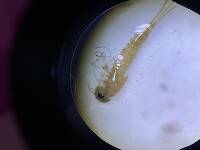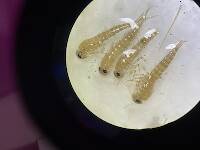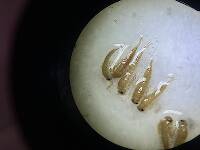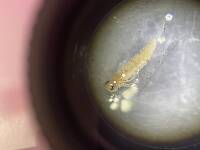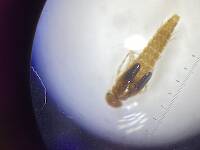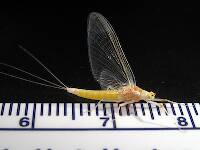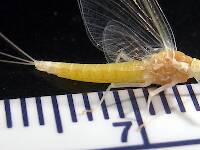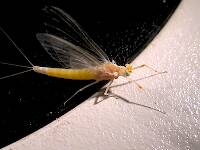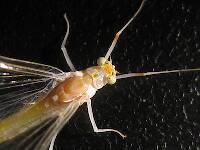
Hex Mayflies
Hexagenia limbata
The famous nocturnal Hex hatch of the Midwest (and a few other lucky locations) stirs to the surface mythically large brown trout that only touch streamers for the rest of the year.
Featured on the forum

Some characteristics from the microscope images for the tentative species id: The postero-lateral projections are found only on segment 9, not segment 8. Based on the key in Jacobus et al. (2014), it appears to key to Neoleptophlebia adoptiva or Neoleptophlebia heteronea, same as this specimen with pretty different abdominal markings. However, distinguishing between those calls for comparing the lengths of the second and third segment of the labial palp, and this one (like the other one) only seems to have two segments. So I'm stuck on them both. It's likely that the fact that they're immature nymphs stymies identification in some important way.

Troutnut is a project started in 2003 by salmonid ecologist Jason "Troutnut" Neuswanger to help anglers and
fly tyers unabashedly embrace the entomological side of the sport. Learn more about Troutnut or
support the project for an enhanced experience here.
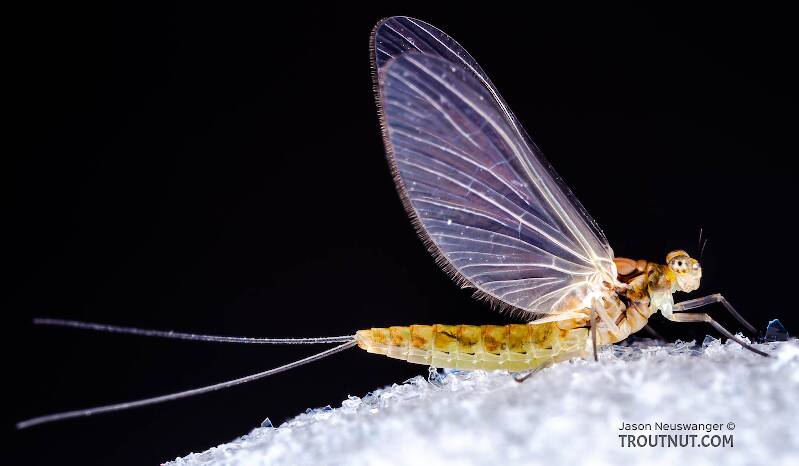
This dun of a fairly large Baetidae species was one of only a couple I saw all evening.
Martinlf on Jun 28, 2012June 28th, 2012, 5:44 am EDT
Now this is some serious bug identification. I was just wondering about the color of the darn things. But it's impressive to see what can go into determining the specifics. Procloeon it is. Now if Shawn or I can just get some shots of those evening hatching "olives."
"He spread them a yard and a half. 'And every one that got away is this big.'"
--Fred Chappell
--Fred Chappell
Entoman on Jun 28, 2012June 28th, 2012, 8:39 am EDT
Now this is some serious bug identification. I was just wondering about the color of the darn things.
Yes, sorry for getting away from your original intent. Lest there be any confusion, the latter part of this thread was focused on Jason's specimen from more than 6 years ago. I don't think there is any debate over my initial responses to your question. Based on what you described, I seriously doubt there is any connection between these two other than possibly sharing the same genus. If I were to hazard a guess, I would still say that your tiny sulfur or tan ones are probably a species of Centroptilum based on commonness. Having said that, there is certainly nothing wrong with referring to them as Procloeon if you wish - it is easier to pronounce.:) To say the concept of speciation in this branch of the Baetidae family is a bit murky is probably an understatement. Discussing the differences between species and placing them in genera using current nomenclature may prove to have been an exercise in grasping at mist some day. Especially when using the old standards of size, color, and hind wing conformation. Heck, we're already there in the latter regard.
Though the tiny olives could be from any number of baetid genera, your suggestion about the possibility of Plauditus is far from dubius.:)
"It's not that I find fishing so important, it's just that I find all other endeavors of Man equally unimportant... And not nearly as much fun!" Robert Traver, Anatomy of a Fisherman
Sherryspinn on Nov 10, 2015November 10th, 2015, 8:56 pm EST
Thanks gentlemen! That was educational.
Quick Reply
Related Discussions
Topic
Replies
Last Reply
0
May 3, 2007
by Troutnut
by Troutnut
8
Jun 5, 2007
by Dinerobyn
by Dinerobyn
12
Oct 29, 2013
by Macalistair
by Macalistair




